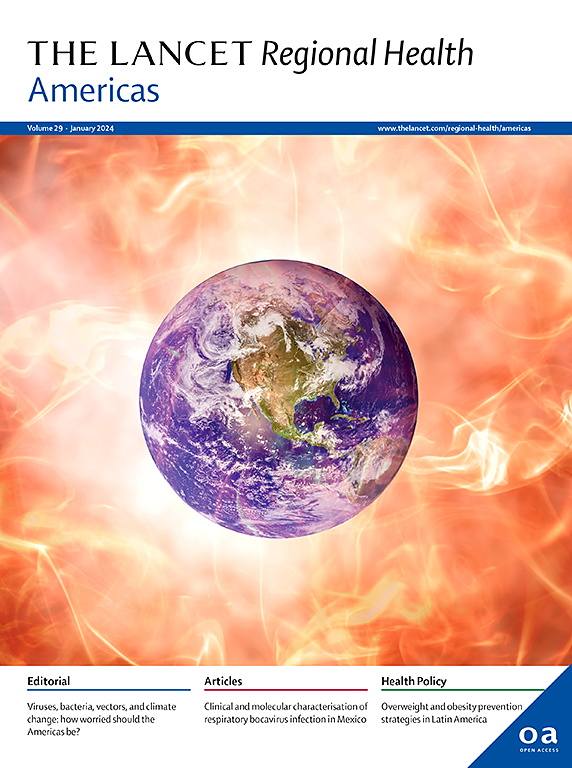Hospitalisation, mortality and years of life lost among chikungunya and dengue cases in Brazil: a nationwide cohort study, 2015–2024
IF 7
Q1 HEALTH CARE SCIENCES & SERVICES
引用次数: 0
Abstract
Background
The incidence of infections from arthropod-borne viruses, including chikungunya and dengue, is increasing globally. We used nationwide data collected over a decade in Brazil to examine the factors associated with hospitalisation, in-hospital mortality, and the years of life lost from these diseases in Brazil.
Methods
Using nationwide de-identified chikungunya and dengue disease records registered from 1st January 2015 to 31 December 2024, we estimated the risk factors for hospitalisation and in-hospital mortality via logistic regression and the Fine and Gray model, respectively. We also calculated the years of life lost for each disease and the average of years of life lost (aYLL), stratified by geographic region, sex and race/ethnicity.
Findings
We studied 1,125,209 chikungunya cases: 21,336 (1.9%) required hospitalisations. Among hospitalised cases, 1044 (4.9%) deaths occurred within 84 days of symptom onset, of which 728 (69.7%) were attributed to chikungunya. We studied 13,741,408 dengue cases: 455,899 (3.3%) required hospitalisation, with 12,969 (2.8%) deaths among the hospitalised cases, with 9989 (77.0%) attributed to dengue. Age (<1 or ≥70 years), sex (male), and the presence of diabetes and kidney disease were risk factors for hospitalisation and in-hospital mortality in both diseases. The aYLL for chikungunya was 16.0 years, and for dengue, 14.5 years; however, the burden was not evenly distributed across the population. For chikungunya, Black participants experienced the highest aYLL of 22.0 years, while White participants were the least affected (aYLL: 13.0). For dengue, the most affected group was Indigenous (aYLL: 22.5) and the least White (aYLL: 12.6).
Interpretation
Infants, older people (≥70 years), male sex and the presence of comorbidities are associated with increased severity in cases of chikungunya and dengue. These diseases disproportionately affect historically minoritised populations, with participants who self-identified as Black and Indigenous experiencing significantly greater years of life lost compared to the white population. Mitigating the impacts of chikungunya and dengue necessitates addressing health and social inequities.
Funding
Royal Society, Wellcome Trust, CNPq.
2015-2024年巴西基孔肯雅热和登革热病例的住院、死亡率和寿命损失:一项全国性队列研究
在全球范围内,包括基孔肯雅热和登革热在内的节肢动物传播病毒感染的发病率正在上升。我们使用巴西十多年来收集的全国数据来研究与巴西住院、住院死亡率和这些疾病导致的寿命损失相关的因素。方法利用2015年1月1日至2024年12月31日登记的全国去鉴定基孔肯雅病和登革热病例,分别通过logistic回归和Fine和Gray模型估计住院和住院死亡率的危险因素。我们还计算了每种疾病的寿命损失年数和平均寿命损失年数(aYLL),按地理区域、性别和种族/民族分层。我们研究了1,125,209例基孔肯雅热病例:21,336例(1.9%)需要住院治疗。在住院病例中,1044例(4.9%)死亡发生在症状出现后84天内,其中728例(69.7%)死于基孔肯雅热。我们研究了13,741,408例登革热病例:455,899例(3.3%)需要住院治疗,住院病例中12,969例(2.8%)死亡,其中9989例(77.0%)归因于登革热。年龄(1岁或≥70岁)、性别(男性)以及是否患有糖尿病和肾脏疾病是两种疾病患者住院和院内死亡的危险因素。基孔肯雅热的平均年龄为16.0岁,登革热为14.5岁;然而,这种负担并不是均匀地分布在人口中。对于基孔肯雅病,黑人参与者的aYLL最高,为22.0年,而白人参与者的aYLL最小(13.0)。对于登革热,受影响最大的群体是土着人(aYLL: 22.5),最小的白人(aYLL: 12.6)。婴儿、老年人(≥70岁)、男性和合并症的存在与基孔肯雅热和登革热病例的严重程度增加有关。这些疾病对历史上的少数民族人口的影响不成比例,与白人人口相比,自我认定为黑人和土著的参与者的寿命损失明显更大。要减轻基孔肯雅热和登革热的影响,就必须解决卫生和社会不平等问题。资助皇家学会,惠康信托基金,CNPq。
本文章由计算机程序翻译,如有差异,请以英文原文为准。
求助全文
约1分钟内获得全文
求助全文
来源期刊

Lancet Regional Health-Americas
Multiple-
CiteScore
8.00
自引率
0.00%
发文量
0
期刊介绍:
The Lancet Regional Health – Americas, an open-access journal, contributes to The Lancet's global initiative by focusing on health-care quality and access in the Americas. It aims to advance clinical practice and health policy in the region, promoting better health outcomes. The journal publishes high-quality original research advocating change or shedding light on clinical practice and health policy. It welcomes submissions on various regional health topics, including infectious diseases, non-communicable diseases, child and adolescent health, maternal and reproductive health, emergency care, health policy, and health equity.
 求助内容:
求助内容: 应助结果提醒方式:
应助结果提醒方式:


